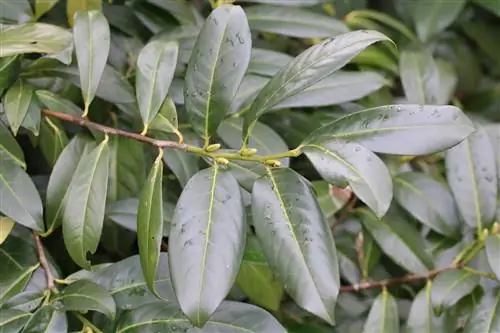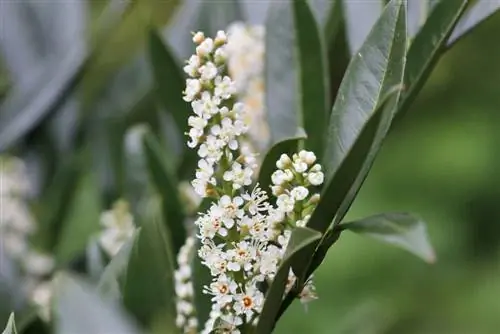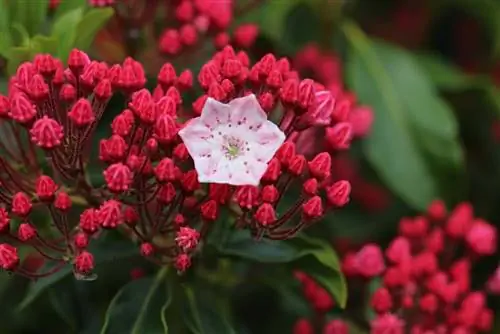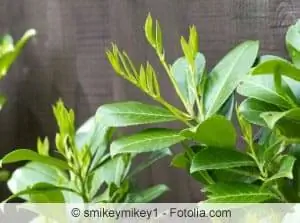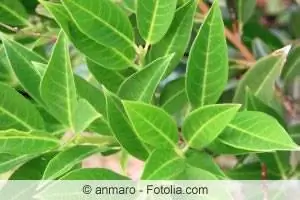- Author admin [email protected].
- Public 2023-12-17 03:39.
- Last modified 2025-01-24 12:45.
Cherry laurel is one of the most popular garden plants and its appearance beautifies any garden. Well-arranged and well-thought-out concepts ensure a harmonious garden structure with high added value. If you think carefully about what you want to plant and what use you want your garden to provide, you should take several important factors into account when planning your garden.
The selection of garden plants plays an important role. Garden owners often ask themselves the following questions:
- Can poisonous plants also move into my garden?
- Should the plants be harmless to humans and animals?
- Should flowering specimens decorate my garden?
- Should the plant be evergreen, i.e. keep the foliage even in winter?
- Should the plant bear fruit decorations?
If you decide to use cherry laurel, it is recommended that you take a close look at the properties of this plant.
Cherry laurel: Far Eastern origin and plausible name
The plant has its origins in Asia Minor or Anatolia. We now have numerous varieties of cherry laurel plants and new hybrids are added from time to time. Also known as the laurel cherry, it is a robust, valuable and resilient plant for the home garden. The plant, which comes from the rose family, is so popular with garden owners because of its appearance and attractive growth behavior. Used in individual positions, in buckets or in groups; The laurel cherry impresses in many different ways.
Botanists and experts usually use their botanical name Prunus laurocerasus to make it easier to distinguish them among the many species and varieties. The name laurel cherry or cherry laurel is based on the appearance of this plant. On the one hand, the plant has a beautiful, large, oval leaf that is shiny on the top. This resembles the appearance of a bay leaf, which supports the name. After the plant has flowered, which can vary depending on the variety, it produces a black drupe. This fruit looks like a cherry and is therefore the name of the cherry laurel.
The berries of the laurel cherry
If you want a direct, concise answer to the question of whether the cherry laurel plant is poisonous, you will promptly be met with a clear “yes”. As beautiful and cherry-like as the plant's black berries may be, they are treacherous for humans. But other parts of the cherry laurel plant can also be poisonous. Garden owners value the plant because of its attractive fruit decoration, which stands out so beautifully with its black berries after flowering. In addition to the already decorative leaf, they appear as an additional highlight.
The garden is very important to its owners. It is not only an attractive decoration, but also a retreat or a place to relax. It offers a meeting place for the family or for barbecuing with friends and acquaintances.
Where the focus is on the family, especially with small children, the demand for “non-toxic” garden plants is becoming increasingly louder. What hardly bothered anyone back then is quickly becoming hotly and intensively discussed in today's very concerned society. Suddenly, if possible, only non-toxic plants should be used in the home garden. If you don't want to choose exclusively herbal plants, you should note that parts of plants other than berries or fruits can be or are poisonous and inedible.
Eating bay cherry berries is generally not recommended. They themselves have a sweet taste with a bitter aftertaste. In some countries the plant is even cultivated for its fruits. The seeds of the fruit are responsible for their toxicity. They convert into the toxic hydrogen cyanide in the stomach. If too many of the seeds are consumed, side effects can occur. Vomiting, cramps, nausea or a racing heart are some possible consequences of eating the fruit seeds. If a quantity of around 10 seeds is consumed, breathing or cardiac arrest can even occur. It is therefore strictly not recommended to eat the berries raw. The situation is different when preserving the cherry laurel fruit. During the process of preserving the berries, the hydrogen cyanide compounds are destroyed. This is how you can cook jam or jelly.
A decorative leaf with a poisonous creature
The cherry laurel is also very popular thanks to its attractive leaves. The individual leaves are large, oval, rich green and shiny on the upper side. The sight can have decorative value in many places in the garden. The laurel cherry is often found as a hedge plant. Four plants should be planted per meter if you want to create a nice, dense hedge. As beautiful as the leaf is, it is unfortunately also poisonous. When consumed in certain quantities, the leaves of the laurel cherry can cause the side effects already mentioned above, such as vomiting, respiratory and cardiac arrest, etc.
What you should know about cherry laurel in brief
The cherry laurel is very popular as an evergreen annual decoration in the garden. Even with its poisonous properties, the plant will probably not lose this status so quickly. What some see as a danger to their garden, others face with a certain calmness. The fact is that it is rare for garden plants to be consumed carelessly by people and animals. With its biodiversity, the cherry laurel has a high ornamental value in our gardens. Presumably, educational work is carried out, for example towards children, rather than the plant being completely banned from the home garden. If you would like to take an intensive look at the use of the laurel cherry berries, you should always consult an expert beforehand.
Using cherry laurel
- Cherry laurel oil is used to relieve cramps.
- It is also used for asthma and whooping cough.
- Homeopathy uses the plant for heart failure, coughs and hoarseness.
Is cherry laurel poisonous?
- This question must be answered with a yes. Not all parts of the cherry laurel are equally poisonous, but if you want to be on the safe side, generally stay away from them.
- The most poisonous are the leaves and seeds of the plant. The fruits, at least the pulp, are not poisonous. Jam is even made from the fruit.
Poisoning from cherry laurel seeds is rare because they have to be crushed. The typical bitter almond smell also occurs. However, the amount of poison contained in cherry laurel seeds is lower than in apricots, peaches, bitter almonds or plums. So you have to be careful, especially with children, that they don't put the fruit in their mouths and bite the core. The leaves also need to be chewed well to release the hydrogen cyanide. In children, the lethal dose is just 10 berries (chewed and swallowed seeds). Since the berries don't taste good, children rarely eat more than one or two pieces.
Recognizing symptoms of poisoning
- After eating several berries or leaves, stomach pain, nausea and vomiting occur.
- Facial flushing occasionally occurs. In rare cases, headaches, dizziness, reduced breathing and loss of consciousness occur.
- Animals such as horses, cows and sheep are at great risk if they eat the leaves of the cherry laurel.
- Just one kilogram of leaves is enough to kill a horse. Pets such as dogs or cats and even birds are also at risk.
Self-help should be avoided. An emergency doctor is the better choice if severe symptoms occur. It is important that the mouth is free of plant parts. The child should also drink enough, preferably lukewarm water. Under no circumstances should you give milk. This promotes the absorption of fat-soluble toxins. S alt water must also not be given as it is too dangerous for children. A stable position on your side is important so that the vomit can drain away.

